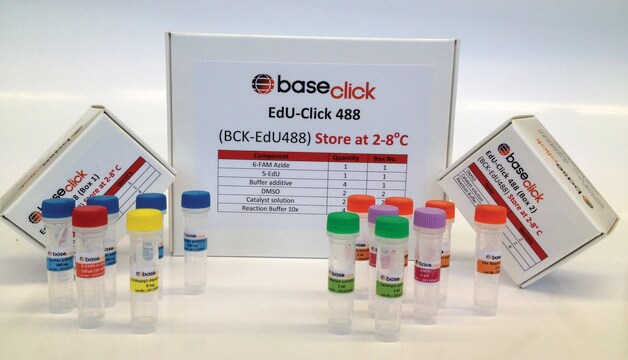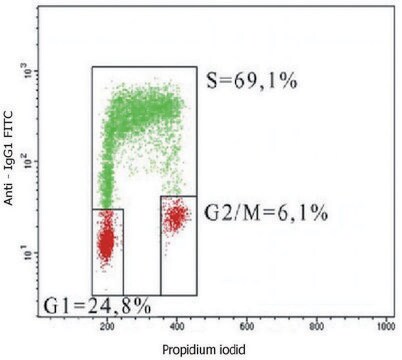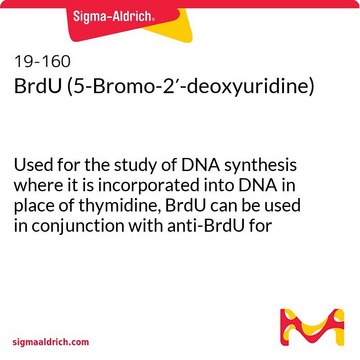BCK647-IV-FC-M
In Vivo EdU Flow Cytometry Kit 647
sufficient for 50 assays
Sign Into View Organizational & Contract Pricing
All Photos(1)
About This Item
UNSPSC Code:
12161503
NACRES:
NA.22
Recommended Products
fluorescence
λex 641 nm; λem 663 nm
shipped in
wet ice
storage temp.
2-8°C
Looking for similar products? Visit Product Comparison Guide
General description
The Baseclick EdU In Vivo Kits provide a superior alternative to BrdU and [3H]thymidine assays for detection of cell proliferation in whole animals, showing no toxic effects. EdU (5-ethynyl-2′-deoxyuridine) is a nucleoside analog to thymidine and is incorporated into DNA during active DNA synthesis. In contrast to BrdU assays, the EdU In Vivo Assays are not antibody based and therefore do not require DNA denaturation for detection of the incorporated nucleoside. Instead, the EdU In Vivo Kits utilize click chemistry for detection in a variety of dye fluorescent readouts. Furthermore, the streamlined detection protocol reduces both the total number of steps and significantly decreases the total amount of time. The simple click chemistry detection procedure is complete within 30 minutes and is compatible with multiplexing for content and context-rich results.The in vivo kits are designed in a sense that you combine one of the three baseclick EdU cell proliferation kits such as:
1. Imaging kit (BCK-IV-IM)
2. Flow cytometry kit (BCK-IV-FC)
3. High throughput screening – HTS kit (BCK-IV-HTS)
You can select the above kits with the dye of choice and the right EdU content for your animal model.
Depending on your animal model or the number of animals to be tested you can choose between three kit sizes S, M, and L with increasing EdU content, as indicated in the following table.
Kit Size Content of EdU
S 50 mg
M 500 mg
L 1000 mg
1. Imaging kit (BCK-IV-IM)
2. Flow cytometry kit (BCK-IV-FC)
3. High throughput screening – HTS kit (BCK-IV-HTS)
You can select the above kits with the dye of choice and the right EdU content for your animal model.
Depending on your animal model or the number of animals to be tested you can choose between three kit sizes S, M, and L with increasing EdU content, as indicated in the following table.
Kit Size Content of EdU
S 50 mg
M 500 mg
L 1000 mg
Application
in Vivo, Flow Cytometry
signalword
Danger
Hazard Classifications
Aquatic Chronic 3 - Carc. 1B - Eye Dam. 1 - Muta. 1B - Repr. 2 - Skin Sens. 1
Storage Class
6.1C - Combustible acute toxic Cat.3 / toxic compounds or compounds which causing chronic effects
Certificates of Analysis (COA)
Search for Certificates of Analysis (COA) by entering the products Lot/Batch Number. Lot and Batch Numbers can be found on a product’s label following the words ‘Lot’ or ‘Batch’.
Already Own This Product?
Find documentation for the products that you have recently purchased in the Document Library.
Maia Dorsett et al.
Genetics, 183(1), 233-247 (2009-07-15)
Germ-line stem cells are unique because they either self-renew through mitosis or, at a certain frequency, switch to meiosis and produce gametes. The switch from proliferation to meiosis is tightly regulated, and aberrations in switching result in either too little
Adrian Salic et al.
Proceedings of the National Academy of Sciences of the United States of America, 105(7), 2415-2420 (2008-02-15)
We have developed a method to detect DNA synthesis in proliferating cells, based on the incorporation of 5-ethynyl-2'-deoxyuridine (EdU) and its subsequent detection by a fluorescent azide through a Cu(I)-catalyzed [3 + 2] cycloaddition reaction ("click" chemistry). Detection of the
Our team of scientists has experience in all areas of research including Life Science, Material Science, Chemical Synthesis, Chromatography, Analytical and many others.
Contact Technical Service










